Lee, Nam, Min, Lee, Han, and Ahn: Characterizations of High Early-Strength Type Shrinkage Reducing Cement and Calcium Sulfo-aluminate by Using Industrial Wastes
Abstract
In this study, the utilization of the by-products of various industries was examined using raw materials of CSA high-functional cement such as coal bottom ash, red mud, phosphate gypsum, etc. Technology to improve energy efficiency and reduce CO2 was developed as part of the manufacturing process; this technology included lower temperature sintering (150 ~ 200°C) than is used in the OPC cement manufacturing process, replacement of CSA cement with the main raw material bauxite, and a determination of the optimum mix condition. In order to develop CSA cement, a manufacturing system was established in the Danyang plant of the HANIL Cement Co. Ltd., in Korea. About 4,200 tons of low purity expansion agent CSA cement (about 16%) and about 850 tons of the lime-based expansion agent dead burned lime (about 8%) were produced at a rate of 60 tons per hour at the HANIL Cement rotary kiln. To improve the OPC cement properties, samples of 10%, 13%, and 16% of CSA cement were mixed with the OPC cement and the compressive strength and length variation rate of the green cement were examined. When green cement was mixed with each ratio of CSA cement and OPC cement, the compressive strength was improved by about 30% and the expansibility of the green cement was also improved. When green cement was mixed with 16% of CSA cement, the compressive strength was excellent compared with that of OPC cement. Therefore, this study indicates the possibility of a practical use of low-cost CSA cement employing industrial wastes only.
Key words: Industrial by-products, CSA expansion admixture, Ettringite, Shrinkage-redicing, Early strength
1. Introduction
On the back of rapid industrialization and development, various industrial byproducts have been generated with increasing amount and thus to deal with the challenges in the area of environment and resources, it’s necessary to develop the high value products using industrial byproducts selectively. Cement industry is appropriate to meet such requirements in terms of ingredient or manufacture process and the study in relevant industries has been underway. As tensile strength of concrete using ordinary Portland cement (hereinafter called OPC) is low and elastic modulus is small which cause the cracks to the concrete because of temperature stress and dry shrinkage by hydration heat in curing process. The efforts to reduce the cracks resulting from such material properties has long been underway, but unless the contractibility of cement paste itself is improved, it’s impossible to fundamentally constrain dry shrinkage and shrinkage crack. To enhance the contractibility of the cement paste, there’s a method to compensate the contraction in a way of generating appropriate expansibility during curing and the material generating such expansion reaction includes calcium sulfo-aluminate (3CaO·3Al 2O 3·CaSO 4, C 4A 3S̄ 1,2)) which is the admixture with superior properties. Calcium sulfo-aluminate (hereinafter called, CSA) which is categorized into hauyne system generates ettringite (C 3A·3CaSO 4·32H 2O), monosul-fate (C 3A·Ca-SO 4·12H 2O) and calcium hydroxide (Ca(OH) 2) in needle shape or pillar shape when mixed with cement and water that generates hydration reaction expands cement concrete and fills micropores that makes possible shrinkage-compensation concrete as well as quick-setting by adjusting the generation of ettringite. 3,4)
In this study, CSA clinker could be produced on cement kiln for commercial production by selecting the industrial byproduct which is favorable in components and properties as well as reducing the material to be mixed and production was made at burning temperature 1,200~1,300°C which is relatively lower than synthetic temperature of OPC clinker. With CSA clinker produced, properties as CSA cement were examined at various conditions with the content of plaster and physical properties as the high early-strength shrink-age-reducing cement were examined by substituting-adding to OPC at certain ratio.
1.1 Theoretic background
1.1.1 Hydration reaction mechanism of expanding admixture
In hydration reaction mechanism of CSA expanding admixture, calcium hydroxide crystal is generated by hydration reaction of free lime as Fig. 1 and contributes to expansion. But calcium hydroxide forms solid solution with aluminate lime as a result of reaction with hauyne and is reduced. Then it generates needle-shaped crystal, called ettringite as a result of reaction with anhydrite which will cause the expansion. Expansion force generated by needle-shaped ettringite contributes effectively to improve dry shrinkage of cement concrete and to make it not to deteriorate the durability, it’s more important to make the balance in timing between cement hydration and curing and expansion. 5-7)
1.1.2 Characteristics and use of CSA
CSA has early strength when containing more Al 2O 3 in combining CaSO 4 and CaO and high strength when containing more SO 3 and expansibility when containing more CaO which thus need to be adjusted properly depending on intended use. Fig. 2 shows the characteristics of the content of components depending on combination of three components of CaO-Al 2O 3-SO 3system Table 1 indicates the characteristics and use of special binder in CSA system.
2. Experimental Procedure
2.1 Starting material
As Al2O3 source, bottom ash and sludge generated from thermal power generation and as SO3 source, phosphoric acid byproduct plaster and as CaO source, limestone used for category 1 OPC manufacture and lime industry were used.
CSA clinker was made by mixing the materials at the ratio, CaO: Al 2O 3: CaSO 4 = 3: 3: 1 and synthesizing in Lab. scale electric furnace at various temperature range, 1,000 ~ 1,400°C and mass production was made with the specimens satisfying the requirements as CSA clinker at pilot plant and in production kiln. Table 2 shows chemical components of materials used.
2.2 Production of CSA clinker
Specimen of CSA clinker was produced at pilot plant where plasticity conditions by process (temperature of preheating tower, pressure, material balance, heat balance) can be monitored ( Fig. 3) and based on process technologies obtained from pilot plant, test production of CSA clinker started on cement kiln for commercial production as Fig. 4 (1,700 ton/day, 300,000 ton/year)
3. Results and Discussion
Physical properties of CSA expansive admixture was reviewed after mixing a certain portion of desulfurized plaster with CSA clinker produced in production kiln.
3.1 Setting time
Setting of CSA expansive admixture was measured vicat device according to KS L 5108. As shown in Fig. 5, initial setting time of category 1 OPC was 5 h and final setting time was 6 h 25 min while initial setting time of CSA expansive admixture was 14 min and final setting was 29 min, which are much faster than category 1 OPC, demonstrating a quick setting performance.
3.2 Change in length
To check early plasticity/dry shrinkage of CSA expansive agent, one meter length change test device was used and the result is as Fig. 6. While category 1 OPC tends to contract in proportion to aging, CSA expansive agent indicated expansibility from the early stage of hydration by generating ettringite. Expansion rate increased rapidly more than category 1 OPC, indicating 280% of expansion rate in maximum.
3.3 Minor hydration heat
Temperature stress is the factor that should not be ignored in concrete crack. More cracks occur in structure with thin section while the cracks in thick structure occur when temperature after rising by hydration heat falls. CSA expansive agent generates minor hydration heat that doubles the category 1 OPC by generating ettringite immediately after injection, but reaction time was maintained for 12 h which was then 1/3 of the value of Chinese-made CSA expansive agent in market ( Fig. 7)
3.4 Hydration product
Hydration product at early stage of CSA expansive agent was analyzed using a scanning electron microscope (sem) and Fig. 8 shows the hydration product in 1 h and 12 h. It’s confirmed that CSA expansive formed hydration product in hexagonal pillar-shaped that is influential on expansion force and thus dry shrinkage and shrinkage crack in cement concrete is expected to be improved by forming ettringite on voids in hardened body.
3.5 Characteristics of early strength shrinkage-reducing cement product
Early strength and shrinkage reduction of category 1 OPC were achieved using CSA expansive agent and physical properties of early strength shrinkage-reducing cement such as minor hydration heat, setting time, fluidity, changes in length, density and compressive strength were examined.
3.5.1 Minor hydration heat
Minor hydration heat of early strength shrinkage-reducing cement measured is as Fig. 9. On the contrary to CSA expansive agent, early hydration heat of early strength shrinkage-reducing cement was similar to category 1 OPC and was slightly increased in 5 h till 17 h.
3.5.2 Setting time and fluidity
Early workability of cement concrete mixed with CSA expansive agent is the critical factor to determine the quality of the product. Fig. 10 shows setting time and fluidity of early strength shrinkage-reducing cement, which indicated setting time earlier than category 1 OPC by 50 minutes by generating ettringite hydrate as much as CSA expansive agent substituted and fluidity, though slightly low in change over time (1 h) had similar properties.
3.5.3 Change in length
Change in length of early strength shrinkage-reducing cement depending on curing condition was examined using contact gauge micrometer method and 1 m length change tester in a bid to maximize the hydration reaction ( Fig. 11) When testing using contact gauge, early strength shrinkage-reducing cement was expanded about 80% of category 1 OPC at early hydration stage and shrinkage reduction by about 25% at late hydration stage. And when it comes to the change in length at air-dried state, shrinkage reduction by about 40% comparing to category 1 OPC was confirmed, which indicated that early strength shrinkage-reducing cement mixed with CSA expansive agent filled the voids on hardened body in proportion to growth pressure of ettringite hydrate crystal that brought about shrinkage reduction effect.
3.5.4 Hydration product
Figure 12 shows the graph comparing hydration products by material age of early strength shrinkage-reducing cement with the photo. Comparing to category 1 OPC of which main hydration product is calcium hydroxide, early strength shrinkage-reducing cement generated ettringite 320% more than category 1 OPC (x-ray diffraction quantitative analysis) and according to observing microstructure, generation of ettringite on the third day was increased from the first day.
3.5.5 Compressive strength and density
As indicated by the test result, compressive strength of early strength shrinkage-reducing cement at early stage, the first day, was increased by 18% comparing to category 1 OPC but was similar at late stage in 28 days. According to the density over time, early strength shrinkage-reducing cement had more dense structure than category 1 OPC because the voids on hardened body were filled with ettringite hydrate ( Fig. 13)
4. Conclusions
CSA expansive agent is produced on cement kiln for commercial production by using industrial byproduct selectively and early strength shrinkage-reducing cement is produced and as a result of analyzing the physical properties of this cement, following conclusion was made.
➀ CSA clinker which is the main material of shrinkage-reducing material could be produced at 1,200 ~ 1,300°C which is lower than synthetic temperature of category 1 OPC clinker. ➁ Furthermore, technology that will minimize the quality deviation through real-time monitoring as well as mass production system with the system compatible with category 1 OPC were developed and secured. ➂ CSA expansive agent generated ettringite hydrate in hexagonal pillar-shaped which improved dry shrinkage and shrinkage crack in cement concrete by filling the voids on hardened body. ➃ Early strength shrinkage-reducing cement using CSA expansive agent indicated increased early compressive strength from category 1 OPC with superior durability without deteriorating the quality which is expected to make commitment to developing the structure at low cost with a long-term service life by improving shrinkage.
Acknowledgments
This research was supported by a grant (2013) from the Energy Technology Development Program (2013T10010 0021), funded by the Ministry of Trade, Industry and Energy of the Korean government.
Fig. 1
Hydration reaction mechanism of CSA expansion admixture. 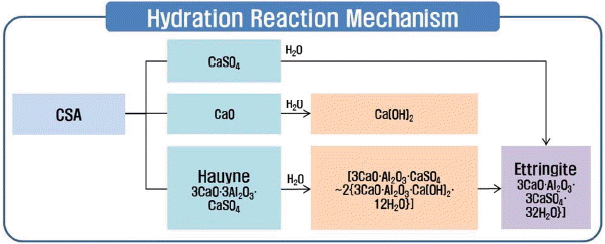
Fig. 2
Relation between chemical composition and properties of additives in the system CaO-Al2O3-SO3. 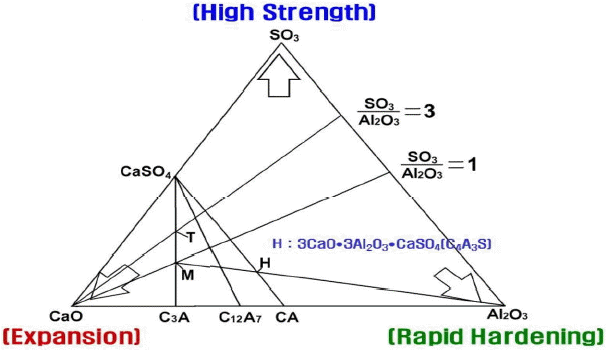
Fig. 3
Green cement pilot plant. 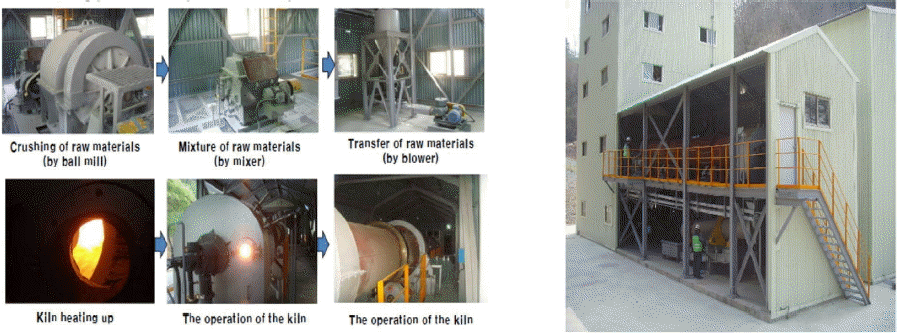
Fig. 4
Cement manufacturing process and kiln. 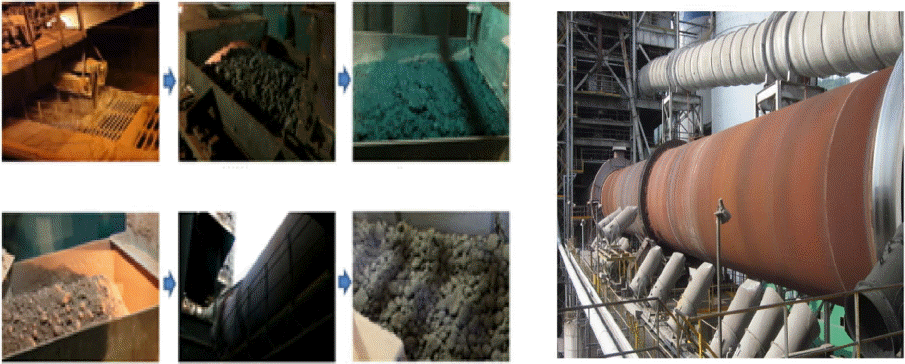
Fig. 5

Fig. 6
Results of 1 m shrink reduction. 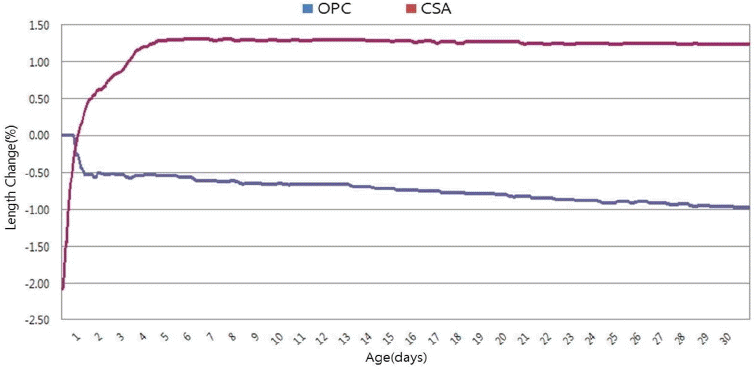
Fig. 7
Results of hydration heat. 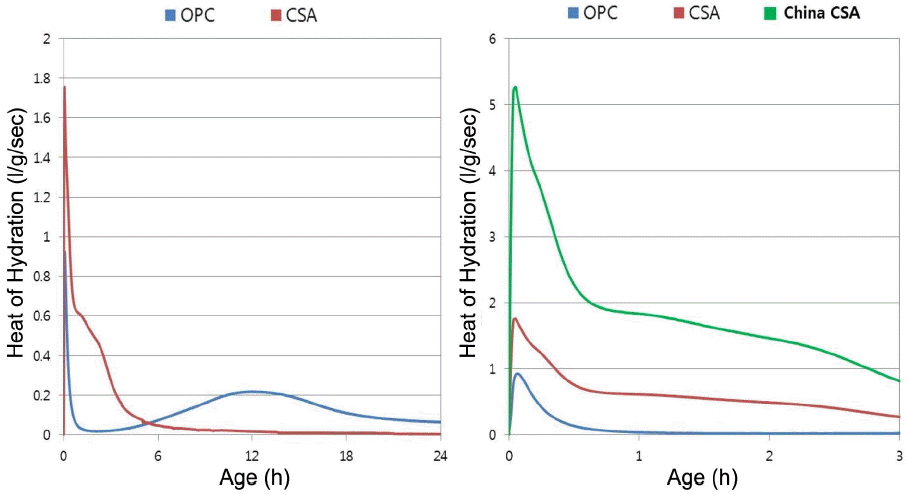
Fig. 8
SEM microphotographs of hardened paste prepared with CSA expansive. 
Fig. 9
Results of hydration heat. 
Fig. 10
Results of setting time and flow. 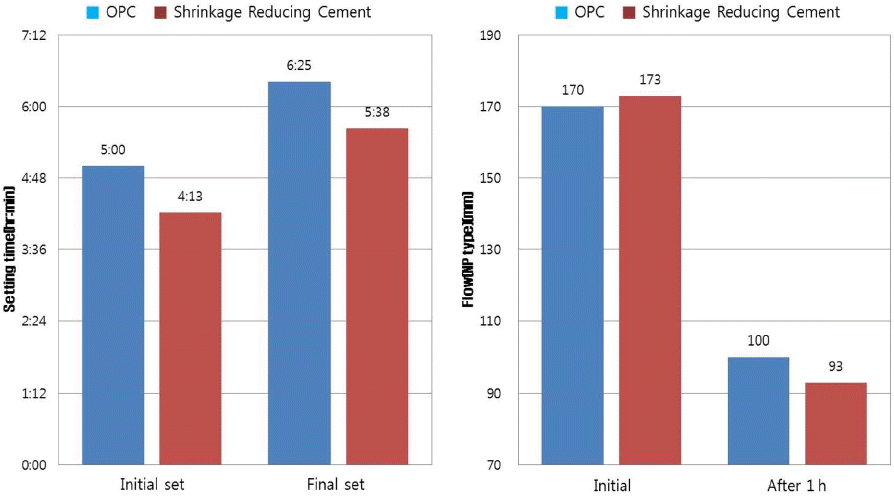
Fig. 11
Results of 1 m shrink reduction. 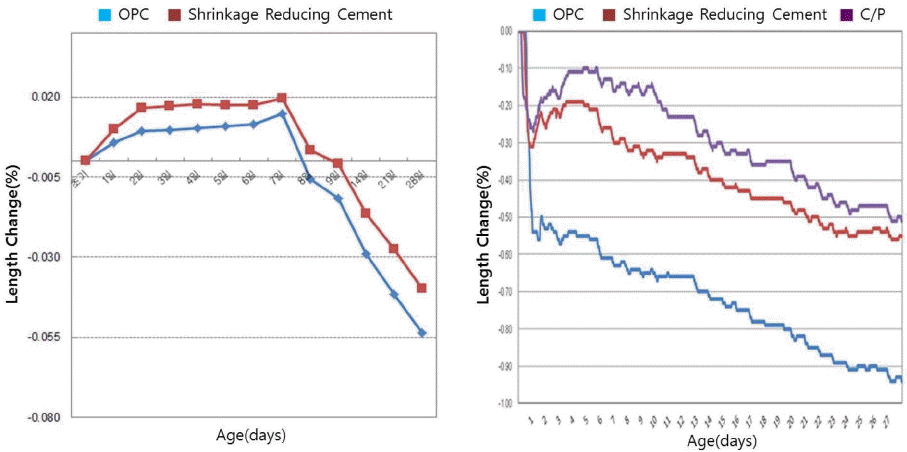
Fig. 12
SEM microphotographs of hardened paste prepared with CSA expansive. 
Fig. 13
Results of compressive strength and porosity. 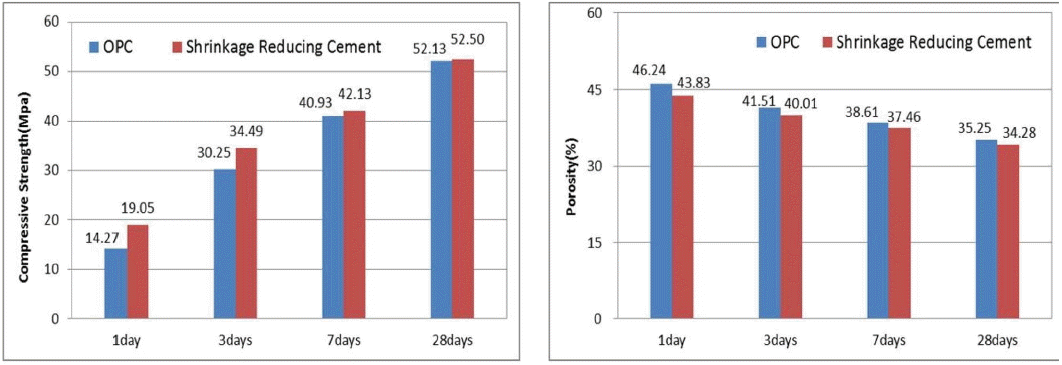
Table 1
CSA System Characteristics and Use of Special Binders
|
CSA System Characteristics |
Use of Special Binders |
|
Expansion |
|
Antiwashout Underwater Cement Heat Resistance Chemical PC Product Microcement Ultra Rapid Hardening Cement Waterproof Coating Selfleveling High Strength Cement Ultra High Early Strength Cement Grout Emergency Repair Concrete High Strength Pile
|
|
High Early Strength and Water Resistance |
To Promote the Initial Hydration Available in Cementation Block Porosity by Ettringite Increase of High Strength and Water Resistance
|
|
Chemical Resistance |
|
Table 2
Chemical Composition of Raw Materials
|
Type |
Chemical Compositions(%) |
|
|
SiO2
|
Al2O3
|
Fe2O3
|
CaO |
SO3
|
MgO |
|
Lime Stone |
9.93 |
1.68 |
0.65 |
45.49 |
0.01 |
2.73 |
|
Bottom Ash |
53.04 |
28.18 |
7.09 |
1.23 |
0.24 |
0.58 |
|
Gypsum |
0.96 |
1.24 |
0.16 |
31.92 |
38.21 |
1.21 |
REFERENCES
1. Yasuo. Arai, Cement Materials Chemistry; Second edition. Dainippon Tosho Publishing Co., Ltd., 1990.
2. GM. George, Industrial Aluminous Cement; pp. 415-470 Applied Science Publishers Ltd, London, 1983.
3. O. Andac, and FP. Glasser, “Polymorphism of Calcium Sulfoaluminate and its Solid Solution,” Adv Cem Res, 22 [6] 57-60 (1994).  4. D. Min, and T. Mingshu, “Formation and Expansion of Ettringite Crystals,” Cem Concr Res, 24 [1] 119-26 (1994).  5. E. Sakaiand, and M. Daimon, “Morpology and Formation of Calcium Aluminate Hydrates,” Inorg Mater, 258 [2] 375-82 (1995).
6. NJ. Calos, CHL. Kennard, AK. Whittaker, and RL. Davis, “Structure of Calcium Aluminate Sulfate Ca4Al6O16S,” J Solid State Chem, 119 [1] 1-7 (1995).  7. K. Okawa, and DM. Roy, “C4A3S Hydration, Ettringite Formation, and its Expansion Mechanism: II. Microstructural Observation of Expansion,” Cem Conc Res, 12 [1] 101-9 (1982). 
|
|
























